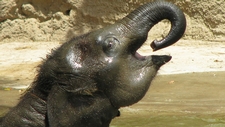Learned Behaviors
Readiness

TEKS Objective
The student is expected to differentiate between inherited traits of plants and animals such as spines on a cactus or shape of a beak and learned behaviors such as an animal learning tricks or a child riding a bicycle.
Essential Understanding
The student knows that organisms undergo similar life processes and have structures that help them survive within their environments.
Science Background
Animal Behavior and Learning: Sea World/Busch Gardens (website) - This site explains how animals are trained at Sea World and Busch Gardens, and includes descriptions of animal training careers and information on how to train pets.
Animal Behavior and Learning
Sea World/Busch Gardens, www.seaworld.org
Signature Lesson
Pets, Oh Behave: Science NetLinks (website) - Students learn the difference between inherited traits and learned behaviors in pets, and develop an understanding of how innate and learned behaviors, combined with the environment, determine behavior. Includes assessment and extensions.
- Supporting Lessons
- Extensions
- Assessment Ideas
- Literature Connections
- Related
TEKS - Additional Resources
Supporting Lessons
Animal Instincts: Discovery Education (website) - Student groups investigate instinctual and learned behavior, understand how an animal's instincts and behaviors help it to survive, and explore connections between environment and behavior. Includes evaluation, extensions, vocabulary and more.
Discovery Education
Animal Instincts, www.discoveryeducation.com
Elaboration Lessons and Extensions
Newton Laws of Motion: Sea World/Busch Gardens (PDF) - Investigate the relationships between animal behaviors and Newton’s Laws of Motion.
Newton Laws of Motion
Sea World/Busch Gardens, www.swbg-animals.org
Animal Behavior and Training: Sea World/Busch Gardens (PDF) - This detailed teacher’s guide for an instructional unit on animal training (learned behaviors) includes background information, images, and a wide range of integrated activities that help students understand behavior patterns of humans and marine animals, and to differentiate between learned behaviors and inherited traits.
Animal Behavior and Training
Sea World/Busch Gardens, www.seaworld.org
Assessment Ideas
Have students create an inventory of learned behaviors among their peers (e.g., what students do when a bell rings during the school day). Then ask students to write short paragraphs describing these different behaviors and hypothesizing about their causes/origins.
Literature Connections
Good Dog! Kids Teach Kids About Dog Behavior and Training. Pang, Evelyn (ISBN-13: 978-1929242580)
When a Gene Makes you Smell Like a Fish. Seachrist-Chiu, Lisa (ISBN-13: 978-0195327069)
You and Your Genes. Johnson, Rebecca (ISBN-13: 978-0792288664)
Albino Animals. Milner-Halls, Kelly (ISBN-13: 978-1581960198)
TEKS Navigation
Grade 5
Need Assistance?
If you need help or have a question please use the links below to help resolve your problem.

Comments